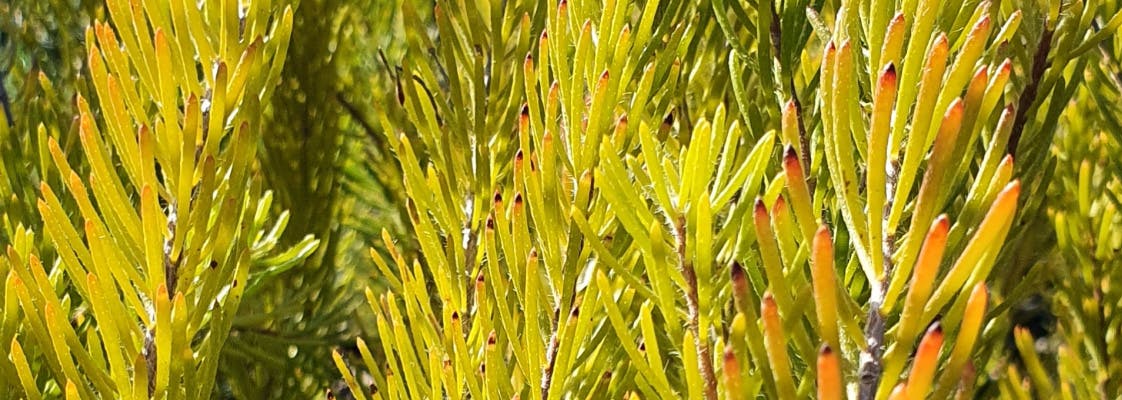
&w=3840&q=75)
Acacia urophylla
Botanical name: Acacia urophylla
Common name: Pointed leaved acaciea/tall leaved acacia/ veined wattle, net-leaved wattle
Description: Erect, slender, open shrub, 0.6 -5 m high. Flowers are yellow/cream-white from May to Oct.
Soil/habitat: Often in lateritic soils. Along creeks & rivers, damp places.
&w=3840&q=75)
Tall Kangaroo Paw
Botanical name: Anigozanthos flavidus
Common name: Tall Kangaroo Paw, Evergreen Kangaroo Paw
Description: Rhizomatous, perennial, herb, 0.5-3m high. Flowers are yellow-green/brown-red from Nov to Dec or Jan.
Soil/habitat: Grey or yellow sand, clay, gravel. Drainage lines, fringing wetlands, roadside gutters.
Cultural use: The roots were eaten either raw or roasted in hot ashes. Sometimes roots were ground into a paste which was then formed into cakes and baked in hot ashes.
&w=3840&q=75)
Mangles Kangaroo Paw
Botanical name: Anigozanthos manglesii
Common name: Mangles Kangaroo Paw, Red and Green Kangaroo Paw
Noongar name: Kurulbrang, Nollamara, Yonga Marra, Knulbora
Description: Rhizomatous, perennial, herb, 0.2-1.1m high. Flowers are green & red from Aug to Nov.
Soil/habitat: White, yellow or grey sand, sandy loam.
Cultural use: The roots were eaten either raw or roasted in hot ashes. Sometimes roots were ground into a paste which was then formed into cakes and baked in hot ashes.
&w=3840&q=75)
Broad Twig Sedge
Botanical name: Baumea preissii
Common name: Broad Twig Sedge
Description: Large rhizomatous perennial sedge, 1.5m high. Flowers are brown from September to October.
Soil/habitat: Watercourses, lakes and swamps.
&w=3840&q=75)
Bluebell Creeper
Botanical name: Billardiera fusiformis
Common name: Bluebell Creeper
Noongar name: Cummock, Kummuck
Description: Sturdy climber. Flowers are Blue/white/pink from Nov to Dec or Jan to Feb.
Soil/habitat: Coastal areas, disturbed water crossing sites.
Cultural use: Blue berries are fleshy and a rich source of Vitamin C. The fruit can be eaten when they turn a transparent pink colour.
&w=3840&q=75)
One-sided Bottlebrush
Botanical name: Calothamnus quadrifidus
Common name: One-sided Bottlebrush
Noongar name: Kwowdjard, Quietjat
Description: Erect, compact or spreading shrub, 0.9-2m high. Flowers are red/white-yellow from Jun to Dec.
Soil/habitat: Wide variety of soils & habitats.
Cultural use: Flowers were a good source of nectar and were either sucked directly or soaked in water to make a sweet drink, often left to ferment to become an alcoholic drink.
&w=3840&q=75)
Gum Tree
Botanical name: Eucalyptus caesia
Common name: Gum Tree
Description: Ornamental tree, 6-8m. Flowers are large pink-red blossoms with yellow stamens from May to Oct. Attracts nectar eating birds, insects.
Soil/habitat:Well drained, sandy, clay, loamy, sandy loam, clay loam, poor soil.
&w=3840&q=75)
Pincushion Hakea
Botanical name: Hakea laurina
Common name: Pincushion Hakea
Description: A large shrub to small tree, 2-5m. Flowers are white, cream, red, pink from May to Oct. Attracts nectar eating birds, butterflies, insects.
Soil/habitat:Well drained, sandy, loamy, sandy loam, clay loam.
&w=3840&q=75)
Cottonwood Hibiscus
Botanical name: Hibiscus tiliaceus Rubra
Common name: Cottonwood Hibiscus
Description: Hardy tropical tree with large heart shaped leaves, up to 5m high and 3.5m width. Flowers are yellow from late winter to spring.
Soil/habitat:Most soil types including clay and salt tolerant.
&w=3840&q=75)
Running Postman
Botanical name: Kennedia prostrata
Common name: Running Postman
Noongar name: Wollung, Pulbarn, Kuralo, Wollong
Description: Prostrate or twining shrub.
Soil/habitat: Usually sandy gravelly soils.
Cultural use: The flowers provide a source of sweet nectar that can be sucked straight from the flower. Leaves are used to make a tea-like drink, which has a pleasant liquorice flavour. Nectar was used to soothe sore throats.

